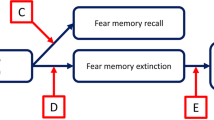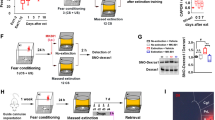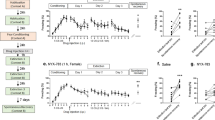Abstract
Rationale
Given that impairment of fear extinction plays a pivotal role in the pathophysiology of posttraumatic stress disorder (PTSD), drugs that facilitate fear extinction may be useful as novel treatments for PTSD. Histone deacetylase (HDAC) inhibitors have recently been shown to enhance fear extinction in animal studies.
Objectives
Using a single prolonged stress (SPS) paradigm, an animal model of PTSD, we examined whether the HDAC inhibitor vorinostat can facilitate fear extinction in rats, and elucidated the mechanism by which vorinostat enhanced fear extinction, focusing on the N-methyl-d-aspartate (NMDA) receptor signals in the hippocampus.
Methods
Seven days after SPS, rats received contextual fear conditioning, followed by 2-day extinction training. Vorinostat was intraperitoneally injected immediately after second extinction training session. Contextual fear response was assessed 24 h after vorinostat injection. Hippocampal tissues were dissected 2 h after vorinostat injection. The levels of mRNA and protein tested were measured by RT-PCR or western blotting, respectively.
Results
Systemic administration of vorinostat with extinction training significantly enhanced fear extinction in SPS rats as compared with the controls. Furthermore, vorinostat enhanced the hippocampal levels of NR2B and calcium/calmodulin kinase II (CaMKII) α and β proteins, accompanied by increases in the levels of acetylated histone H3 and H4.
Conclusions
These findings suggest that vorinostat ameliorated the impaired fear extinction in SPS rats, and this effect was associated with an increase in histone acetylation and thereby enhancement of NR2B and CaMKII in the hippocampus. Our results may provide new insight into the molecular and therapeutic mechanisms of PTSD.







Similar content being viewed by others
References
Alarcon JM, Malleret G, Touzani K, Vronskaya S, Ishii S, Kandel ER, Barco A (2004) Chromatin acetylation, memory, and LTP are impaired in CBP+/- mice: a model for the cognitive deficit in Rubinstein-Taybi syndrome and its amelioration. Neuron 42:947–959. doi:10.1016/j.neuron.2004.05.021
Bayer KU, LeBel E, McDonald GL, O'Leary H, Schulman H, De Koninck P (2006) Transition from reversible to persistent binding of CaMKII to postsynaptic sites and NR2B. The Journal of Neuroscience: the Official Journal of the Society for Neuroscience 26:1164–1174. doi:10.1523/JNEUROSCI.3116-05.2006
Blechert J, Michael T, Vriends N, Margraf J, Wilhelm FH (2007) Fear conditioning in posttraumatic stress disorder: evidence for delayed extinction of autonomic, experiential, and behavioural responses. Behav Res Therapy 45:2019–2033. doi:10.1016/j.brat.2007.02.012
Bredy TW, Barad M (2008) The histone deacetylase inhibitor valproic acid enhances acquisition, extinction, and reconsolidation of conditioned fear. Learn Mem 15:39–45. doi:10.1101/lm.801108
Bredy TW, Wu H, Crego C, Zellhoefer J, Sun YE, Barad M (2007) Histone modifications around individual BDNF gene promoters in prefrontal cortex are associated with extinction of conditioned fear. Learn Mem 14:268–276. doi:10.1101/lm.500907
Buchwald M, Kramer OH, Heinzel T (2009) HDACi–targets beyond chromatin. Cancer Lett 280:160–167. doi:10.1016/j.canlet.2009.02.028
Davis M (2011) NMDA receptors and fear extinction: implications for cognitive behavioral therapy. Dialogues Clin Neurosci 13:463–474
Davis M, Myers KM, Chhatwal J, Ressler KJ (2006) Pharmacological treatments that facilitate extinction of fear: relevance to psychotherapy. NeuroRx 3:82–96. doi:10.1016/j.nurx.2005.12.008
Faraco G, Pancani T, Formentini L, Mascagni P, Fossati G, Leoni F, Moroni F, Chiarugi A (2006) Pharmacological inhibition of histone deacetylases by suberoylanilide hydroxamic acid specifically alters gene expression and reduces ischemic injury in the mouse brain. Mol Pharmacol 70:1876–1884. doi:10.1124/mol.106.027912
Friedman MJ, Charney DS, Deutch AY (1995) Neurobiological and clinical consequences of stress. Lippincott-Raven, Philadelphia
Fujita Y, Morinobu S, Takei S, Fuchikami M, Matsumoto T, Yamamoto S, Yamawaki S (2012) Vorinostat, a histone deacetylase inhibitor, facilitates fear extinction and enhances expression of the hippocampal NR2B-containing NMDA receptor gene. J Psychiatric Res 46:635–643. doi:10.1016/j.jpsychires.2012.01.026
Guan JS, Haggarty SJ, Giacometti E, Dannenberg JH, Joseph N, Gao J, Nieland TJ, Zhou Y, Wang X, Mazitschek R, Bradner JE, DePinho RA, Jaenisch R, Tsai LH (2009) HDAC2 negatively regulates memory formation and synaptic plasticity. Nature 459:55–60. doi:10.1038/nature07925
Imanaka A, Morinobu S, Toki S, Yamawaki S (2006) Importance of early environment in the development of post-traumatic stress disorder-like behaviors. Behavioural Brain Res 173:129–137. doi:10.1016/j.bbr.2006.06.012
Iwamoto Y, Morinobu S, Takahashi T, Yamawaki S (2007) Single prolonged stress increases contextual freezing and the expression of glycine transporter 1 and vesicle-associated membrane protein 2 mRNA in the hippocampus of rats. Progress in Neuro-Psychopharmacology and Biological Psychiatry 31:642–651. doi:10.1016/j.pnpbp.2006.12.010
Kaplan GB, Moore KA (2011) The use of cognitive enhancers in animal models of fear extinction. Pharmacology Biochemistry Behav 99:217–228. doi:10.1016/j.pbb.2011.01.009
Kilgore M, Miller CA, Fass DM, Hennig KM, Haggarty SJ, Sweatt JD, Rumbaugh G (2010) Inhibitors of class 1 histone deacetylases reverse contextual memory deficits in a mouse model of Alzheimer's disease. Neuropsychopharmacology 35:870–880. doi:10.1038/npp.2009.197
Lattal KM, Barrett RM, Wood MA (2007) Systemic or intrahippocampal delivery of histone deacetylase inhibitors facilitates fear extinction. Behav Neurosci 121:1125–1131. doi:10.1037/0735-7044.121.5.1125
Ledgerwood L, Richardson R, Cranney J (2005) D-cycloserine facilitates extinction of learned fear: effects on reacquisition and generalized extinction. Biol Psychiatry 57:841–847. doi:10.1016/j.biopsych.2005.01.023
Liberzon I, Krstov M, Young EA (1997) Stress-restress: effects on ACTH and fast feedback. Psychoneuroendocrinology 22:443–453. doi:10.1016/S0306-4530(97)00044-9
Liberzon I, Lopez JF, Flagel SB, Vazquez DM, Young EA (1999) Differential regulation of hippocampal glucocorticoid receptors mRNA and fast feedback: relevance to post-traumatic stress disorder. J Neuroendocrinology 11:11–17. doi:10.1046/j.1365-2826.1999.00288.x
Litz BT, Salters-Pedneault K, Steenkamp MM, Hermos JA, Bryant RA, Otto MW, Hofmann SG (2012) A randomized placebo-controlled trial of d-cycloserine and exposure therapy for posttraumatic stress disorder. Journal of Psychiatric Research. doi:10.1016/j.jpsychires.2012.05.006
Mathes CM, Gregson JR, Spector AC (2012) The selective serotonin reuptake inhibitor paroxetine decreases breakpoint of rats engaging in a progressive ratio licking task for sucrose and quinine solutions. Chem Senses. doi:10.1093/chemse/bjs096
Milad MR, Rauch SL, Pitman RK, Quirk GJ (2006) Fear extinction in rats: implications for human brain imaging and anxiety disorders. Biol Psychol 73:61–71. doi:10.1016/j.biopsycho.2006.01.008
Milad MR, Pitman RK, Ellis CB, Gold AL, Shin LM, Lasko NB, Zeidan MA, Handwerger K, Orr SP, Rauch SL (2009) Neurobiological basis of failure to recall extinction memory in posttraumatic stress disorder. Biol Psychiatry 66:1075–1082. doi:10.1016/j.biopsych.2009.06.026
Myers KM, Carlezon WA Jr (2012) D-cycloserine effects on extinction of conditioned responses to drug-related cues. Biol Psychiatry 71:947–955. doi:10.1016/j.biopsych.2012.02.030
Nicoll RA, Malenka RC (1995) Contrasting properties of two forms of long-term potentiation in the hippocampus. Nature 377:115–118. doi:10.1038/377115a0
Norberg MM, Krystal JH, Tolin DF (2008) A meta-analysis of D-cycloserine and the facilitation of fear extinction and exposure therapy. Biol Psychiatry 63:1118–1126. doi:10.1016/j.biopsych.2008.01.012
Peleg S, Sananbenesi F, Zovoilis A, Burkhardt S, Bahari-Javan S, Agis-Balboa RC, Cota P, Wittnam JL, Gogol-Doering A, Opitz L, Salinas-Riester G, Dettenhofer M, Kang H, Farinelli L, Chen W, Fischer A (2010) Altered histone acetylation is associated with age-dependent memory impairment in mice. Science 328:753–756. doi:10.1126/science.1186088
Powers MB, Halpern JM, Ferenschak MP, Gillihan SJ, Foa EB (2010) A meta-analytic review of prolonged exposure for posttraumatic stress disorder. Clinical Psychology Rev 30:635–641. doi:10.1016/j.cpr.2010.04.007
Rauch SL, Shin LM, Phelps EA (2006) Neurocircuitry models of posttraumatic stress disorder and extinction: human neuroimaging research–past, present, and future. Biol Psychiatry 60:376–382. doi:10.1016/j.biopsych.2006.06.004
Robison AJ, Bartlett RK, Bass MA, Colbran RJ (2005) Differential modulation of Ca2+/calmodulin-dependent protein kinase II activity by regulated interactions with N-methyl-D-aspartate receptor NR2B subunits and alpha-actinin. The J Biological Chemistry 280:39316–39323. doi:10.1074/jbc.M508189200
Rothbaum BO, Davis M (2003) Applying learning principles to the treatment of post-trauma reactions. Annals N Y Academy Sciences 1008:112–121. doi:10.1196/annals.1301.012
Sanhueza M, Fernandez-Villalobos G, Stein IS, Kasumova G, Zhang P, Bayer KU, Otmakhov N, Hell JW, Lisman J (2011) Role of the CaMKII/NMDA receptor complex in the maintenance of synaptic strength. The Journal of Neuroscience: the Official Journal of the Society for Neuroscience 31:9170–9178. doi:10.1523/JNEUROSCI.1250-11.2011
Stafford JM, Raybuck JD, Ryabinin AE, Lattal KM (2012) Increasing histone acetylation in the hippocampus-infralimbic network enhances fear extinction. Biol Psychiatry 72:25–33. doi:10.1016/j.biopsych.2011.12.012
Strawn JR, Keeshin BR, DelBello MP, Geracioti TD Jr, Putnam FW (2010) Psychopharmacologic treatment of posttraumatic stress disorder in children and adolescents: a review. J Clin Psychiatry 71:932–941. doi:10.4088/JCP.09r05446blu
Suenaga T, Morinobu S, Kawano K, Sawada T, Yamawaki S (2004) Influence of immobilization stress on the levels of CaMKII and phospho-CaMKII in the rat hippocampus. Int J Neuropsychopharmacol 7:299–309. doi:10.1017/s1461145704004304
Szapiro G, Vianna MR, McGaugh JL, Medina JH, Izquierdo I (2003) The role of NMDA glutamate receptors, PKA, MAPK, and CAMKII in the hippocampus in extinction of conditioned fear. Hippocampus 13:53–58. doi:10.1002/hipo.10043
Takahashi T, Morinobu S, Iwamoto Y, Yamawaki S (2006) Effect of paroxetine on enhanced contextual fear induced by single prolonged stress in rats. Psychopharmacology 189:165–173. doi:10.1007/s00213-006-0545-6
Takei S, Morinobu S, Yamamoto S, Fuchikami M, Matsumoto T, Yamawaki S (2010) Enhanced hippocampal BDNF/TrkB signaling in response to fear conditioning in an animal model of posttraumatic stress disorder. J Psychiatric Res 45:460–468. doi:10.1016/j.jpsychires.2010.08.009
Tang YP, Shimizu E, Dube GR, Rampon C, Kerchner GA, Zhuo M, Liu G, Tsien JZ (1999) Genetic enhancement of learning and memory in mice. Nature 401:63–69. doi:10.1038/43432
Walker DL, Ressler KJ, Lu KT, Davis M (2002) Facilitation of conditioned fear extinction by systemic administration or intra-amygdala infusions of D-cycloserine as assessed with fear-potentiated startle in rats. J Neuroscience 22:2343–2351
Whittle N, Schmuckermair C, Gunduz Cinar O, Hauschild M, Ferraguti F, Holmes A, Singewald N (2013) Deep brain stimulation, histone deacetylase inhibitors and glutamatergic drugs rescue resistance to fear extinction in a genetic mouse model. Neuropharmacology 64:414–423. doi:10.1016/j.neuropharm.2012.06.001
Yamamoto S, Morinobu S, Fuchikami M, Kurata A, Kozuru T, Yamawaki S (2008) Effects of single prolonged stress and D-cycloserine on contextual fear extinction and hippocampal NMDA receptor expression in a rat model of PTSD. Neuropsychopharmacology 33:2108–2116. doi:10.1038/sj.npp.1301605
Yamamoto S, Morinobu S, Takei S, Fuchikami M, Matsuki A, Yamawaki S, Liberzon I (2009) Single prolonged stress: toward an animal model of posttraumatic stress disorder. Depression and Anxiety 26:1110–1117. doi:10.1002/da.20629
Yamane F (2001) Reduction in serotonin synthesis following acute and chronic treatments with paroxetine, a selective serotonin reuptake inhibitor, in rat brain: An autoradiographic study with α-[14C]methyl-L-tryptophan. Biochem Pharmacol 62:1481–1489. doi:10.1016/S0006-2952(01)00798-5
Yeh SH, Lin CH, Gean PW (2004) Acetylation of nuclear factor-kappaB in rat amygdala improves long-term but not short-term retention of fear memory. Mol Pharmacol 65:1286–1292. doi:10.1124/mol.65.5.1286
Funding and grants
This work was supported by a grant-in-aid for general scientific research from the Ministry of Education, Science, and Culture of Japan, a Health Science Research Grant for Research on Brain Science from the Ministry of Health and Welfare of Japan, and a grant from Core Research for Evolutional Science and Technology (CREST) of Japan Science and Technology (JST).
Conflict of interest
All authors declare that they have no conflicts of interest.
Author information
Authors and Affiliations
Corresponding author
Electronic supplementary material
Below is the link to the electronic supplementary material.
ESM 1
(PDF 318 kb)
Rights and permissions
About this article
Cite this article
Matsumoto, Y., Morinobu, S., Yamamoto, S. et al. Vorinostat ameliorates impaired fear extinction possibly via the hippocampal NMDA-CaMKII pathway in an animal model of posttraumatic stress disorder. Psychopharmacology 229, 51–62 (2013). https://doi.org/10.1007/s00213-013-3078-9
Received:
Accepted:
Published:
Issue Date:
DOI: https://doi.org/10.1007/s00213-013-3078-9




